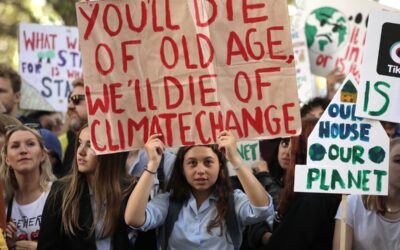How much should people in Britain worry about food security? Here’s a starter for ten, taken from a recent Guardian article by Harriet Green:
For three years, my husband has talked about taking to the hills. About buying a smallholding on Exmoor where, with our four-year-old daughter, we can safely survive the coming storm – famine, pestilence and a total breakdown of society. I would wait for his lectures to finish, then return to my own interests. I had no time for the end of civilisation. As an editor on a glossy magazine until a few months ago, I was too busy. There was always a new Anya Hindmarch bag to buy, or a George Clooney premiere to attend.
But recently, I’ve wavered. Much of what he has been predicting has come true: global economic meltdown, looming environmental disaster, a sharp rise in oil and food prices that has already led to the rationing of rice in the US, and riots in dozens of countries worldwide. This week, the details got scarier. The UN warned of a global food crisis, like a “silent tsunami”, while Opec predicts that oil, which broke through $100 (£50) a barrel for the first time a few weeks ago, may soon top $200.
In one sense, it’s no surprise that food figures so prominently in her list of concerns: along with shelter and water, after all, food is about as basic as human needs get. But on the other hand, you have to wonder: if you can afford Anya Hindmarch bags, do you really have anything to worry about on food prices? Isn’t the problem actually the converse – namely that as the global middle class grows, its appetite for meat and dairy products (and handbags too) also grows – taking staple grains out of the purchasing power reach of poorer consumers in the process?
Still, the fact remains: people in developed countries who think about resilience a lot are worried about food. John Robb, for instance, sees food as a critical dimension of his concept of the Resilient Community. Or look at the Transition Towns movement in Totnes, who are going nuts about food security (literally):
… the idea is to use town-wide plantings [of nut trees] to create a stock of healthy, productive trees that can serve as a great source of local food, and a buffer in times of scarcity. The reason that the group is concentrating on nut trees is their potential to outgrow cereal crops in terms of carbohydrates, and to utilise poorer soils with fewer inputs. The group has already planted hazelnuts, walnuts and almonds across the town …
So: how worried should we be in Britain, the US or other developed countries? Is it time to head for the hills?
Differentiating the risks
Well, start by differentiating three different kinds of food insecurity.
First, imagine an acute, short-term supply interruption. Suppose that there’s another fuel crisis like the one in 2000, for instance, and that supermarket supply chains crash, with the whole process accelerated by panic-buying. In policy terms, the main job for central and local government in this scenario would be (a) do everything to sort out the underlying trigger of the supply interruption, if possible; (b) try to limit panic-buying and hoarding; (c) deliver emergency relief. (There might well be limits to how much government can achieve in all three of these areas.)
Now, imagine the opposite: a long term condition of insufficiency. Think, for example, of Britain’s food supply during World War Two, and imagine similar circumstances arising today. In contrast to the first example, normal service will not be resumed shortly in this scenario. Here, the task of government would be much more extensive. Rationing would presumably need to be organised, together with a national crash programme of growing staples (wheat, potatoes) and urban gardening – dusting off Lord Woolton‘s WW2 manual, in short.
And then imagine a third example: where the problem is simply that prices go up, and up, and up – over a period of years perhaps – as the result of global supply simply failing to keep pace with global demand. Unlike the first two examples, we’d expect to see plenty of food on the shelves here – but for only for those that could afford it (this is of course exactly what many developing country cities are currently experiencing). Here, the immediate challenge is social protection for vulnerable people – followed, in the longer term, by a plan for growing supply and/or easing demand.
Now what interests me about the idea of the Resilient Community or the Transition Town is that it’s not always immediately clear which of these three scenarios they’re best suited to guard against. Let’s go through them again one by one and have a look.
The World War Two scenario
Start with the second scenario. I have a hunch that when people imagine a condition of food stress in the UK, this is the one that they reach for instinctively – because it chimes with our nostalgia for the war years (even those of us who weren’t born in 1945), and folk memories of ‘Dig for Victory’. We love this stuff: if you went to St James’s Park a few weeks back, you could find a perfect replica of a World War Two allotment. And of course, a Resilient Community or Transition Town today would be just the ticket were World War Two to start again tomorrow.
The problem is that of the three scenarios set out here, I think this is the least likely today. To achieve the kind of sudden reduction in trade that Britain experienced during the war would take just that: a major inter-state conflict. It’s virtually impossible to see how a terrorist group could achieve such an extensive goal (though if it was very lucky, it might be able to provoke a government into being stupid enough to do the job on its behalf, e.g. by insisting on searches of every shipping container to arrive at the border).
So although transition towns look well designed as a strategy for dealing with this eventuality, the likelihood factor scores less strongly. The other two scenarios look much more feasible. So how do Transition Towns shape up against them?
The supermarket sweep scenario
Look now at the first scenario – that of acute supply interruption and empty shelves. This one looks a lot more possible: indeed, as recent panic-buying of rice in the US showed, you can fall into this scenario on the basis of rumour and perception alone, without any actual perturbation on the supply side.
Here, the idea of the Resilient Community as a buffer against short term interruptions looks useful. If, for instance, a supply interruption lasted for a couple of weeks, then some kind of endogenous capacity – domestic food stockpiles, local market gardening and the like – could make the difference between a bloody nuisance and something much more nasty.
But with that said, I think we need to be cautious of any blanket assumption that “more local = more resilient”. Imagine, for a moment, a scenario in which the UK were mostly self-sufficient in food. Now imagine a year of catastrophic freak weather (not difficult, these days). All of a sudden, diversified global supply chains look like a significant source of resilience.
Similarly, we might need to be careful of assuming that supermarket supply chains are fragile because they rely on just-in-time inventory management. In one sense, of course, systems are fragile when the buffers are stripped out: the reason you’re likely to get delayed on a Ryanair flight is because the turnaround times are so short that there’s no margin for error, and plenty of scope for cascading failures. But on the other hand, the sophistication of supermarkets’ distribution management can also be a source of resilience: if one supply depot goes down, it’s relatively straightforward to switch routing through other parts of the network- if the management systems are up to it.
So rather than assuming that local production is more safe, we might do better to think of resilience deriving from the right blend of local, national and global supply chains. As we’ll see in a moment, that raises big questions about what sort of trade system might best faciliate that – but the key point for now is that it’s not clear that “localisation is the answer”; we need a more nuanced narrative than that.
The food inflation scenario
So now turn to the food inflation scenario – which currently looks to be the likeliest (indeed, it’s already here). For developing countries like the Philippines (which has said it wants to be self-sufficient in rice within 3 years), it’s easy to see why ‘food independence’ is an attractive idea: world grain markets haven’t proved quite as reliable as the World Bank suggested.
But for the UK and other developed economies, it’s a different story. The blunt fact is that their wealth allows them to outbid everyone else. That’s why India suspended rice exports to Bangladesh, while cheerfully continuing to ship basmati rice to developed country markets; and it’s why Haiti, Egypt and Indonesia have seen food riots, while Norway, Canada and New Zealand have not. While EU Trade Commissioner Peter Mandelson, World Bank President Bob Zoellick or UK Prime Minister Gordon Brown all argue that further trade liberalisation will help poor countries, there are also good reasons to wonder whether it might not do the opposite: make it easier for rich countries and consumers to outbid poorer ones.
True, there’s the fact that while food prices may account for a small proportion of spending for the average OECD consumer (as opposed to the 50-60% in low income country households), that still leaves the question of poor consumers in rich countries (see Chris Bryant’s excellent FT article on hunger in America from last month). But even there, it’s hard to see why increasing self-sufficiency would be a better bet than simply increasing welfare provision. Admittedly, the political climate is currently inconducive to more generous welfare entitlements; but in a real long term slump, I suspect the political will would likely materialise (c.f. the New Deal).
So from a purely resilience-based standpoint – leaving aside questions of justice and fairness for a moment – it looks like Transition Towns might be just the ticket for Manila, but not necessarily in Manchester or Minneapolis, with their greater purchasing power.
But in practice, we should take those questions of justice and fairness into account. If Britain’s international food security strategy is no more imaginative than “we’re richer than you; piss off”, then shame on us. But let’s be clear: at this point, we’re talking about a bigger project than just local resilience: we’re talking about global resilience, through the means of global justice. It’s a very different project.
Once we’re clear that we are talking about global justice – trying to find a system that feeds everyone healthily, rather than just our community – we need to start from first principles, which means not assuming that localisation will be right for everyone. As I asked in my post on food yesterday, what about Saudi Arabia: are they supposed to go self-sufficient with 27 million people? So that brings us back to trade. It’s far from clear that liberalisation is the answer; but neither is it clear that self-sufficiency is workable. We need a different approach again – fast.
So what does all this add up to?
In a nutshell, the following very tentative conclusions:
– we need to be clear that there are different potential sources of food risk for the UK, with very different drivers, impacts and policy implications;
– the scenario that the public perhaps most fears instinctively – a WW2-like situation of insufficient food supplies over a sustained period, even for those with cash to pay for it – is probably the least likely of the three;
– local food systems can add additional resilience, especially to short term supply chain interruptions, but probably as a complement for national and international systems rather than a replacement for them;
– while developed country resilience to long term price inflation (which we can already see) is boosted by the fact that they can afford to outbid other consumers for food (and energy), that’s the basis of a very regressive foreign policy: we should aim for a more enlightened international approach;
– and trade is absolutely central to this. Neither liberalisation nor self-sufficiency looks like the answer. All in all, we need a more sophisticated approach than “global vs local”.



